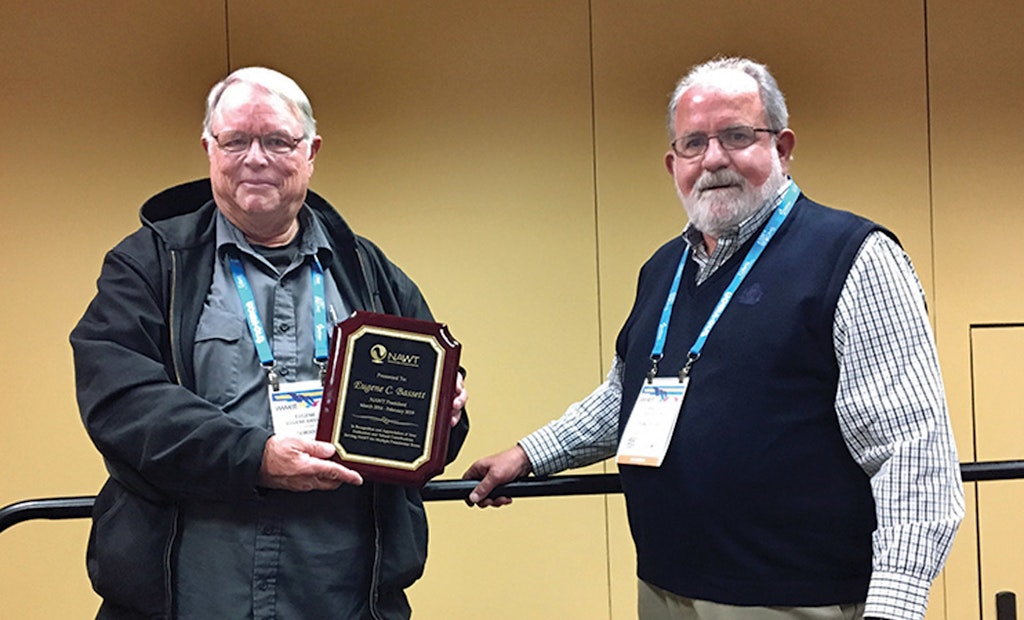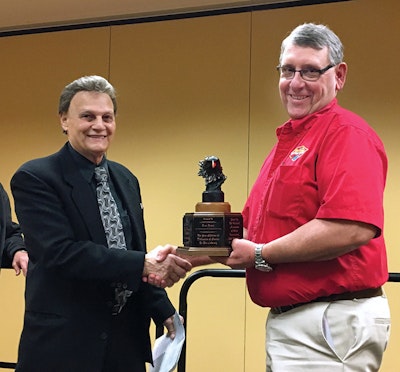
Gene Bassett, left, the outgoing president of the National Association of Wastewater Technicians, receives an award of appreciation from incoming President Bruce Fox.
I think pumpers are sometimes unfairly criticized for disposal practices by local government officials who don’t understand how the wastewater industry is regulated and a public influenced by an “ick factor” when it comes to conveyance of septic tank waste.
It seems like rural neighbors are quick to play the blame game the first time they note a whiff of odor coming from a septic service business. And nothing packs a town hall as fast as a pumper who wants to expand his operation to include land spreading or storage of septage.
It’s easy for the not-in-my-back-yard, or NIMBY, folks to rise and attempt to squash the plans of a legitimate business owner who is taking care of a problem caused by the entire community. Nevermind that everyone out in the country has a septic tank and the contents need to be disposed of responsibly by a county- or state-approved method. Waste producers too often just want the problem to be flushed away and never dealt with again.
This happens occasionally in my area of northeast Wisconsin, where land application is still allowed and is typically conducted in a professional manner and overseen by health department regulators. In one serious and ongoing water crisis in my neighboring county, septic systems and a new type of factory dairy farm operation have seemingly been given equal blame for the problems. Until recently, that is.
COULD HAPPEN ANYWHERE
The explosive situation in Kewaunee County, along Lake Michigan near Green Bay, showed in 2017 research that 60% of homes had wells contaminated by fecal microbes — which can be found in both failing septic systems and animal waste. In the county with about 20,000 residents and generally shallow depth of soil to bedrock, it doesn’t take so much for contaminants to reach the drinking water supply.
It’s not unusual for so-called experts to bring up both septic systems and intensive farming operations when reacting to water-quality issues in areas served by onsite systems. Look at the ongoing saga of the so-called red tide of algal blooms plaguing vast tourism areas in Florida. This serious pollution problem is caused by excess nitrates in the water. Many have been quick to blame septic systems for the problem, and they are likely one contributing factor.
In the case of Florida, who would blame anyone for pointing a finger at decentralized wastewater? The state has a problem with failing systems and a very high groundwater table, and legislators can’t make up their minds how they want to regulate system performance. In a few short years, state legislators proposed stricter maintenance guidelines for septic systems, then abandoned them citing high cost of pumping and inspections, and now are swinging back toward stronger oversight.
Lots of systems are outdated and completely ignored, leading folks to doubt the effectiveness of onsite wastewater treatment. Pumpers from across the country frequently tell me they respond to emergency calls where a tank hasn’t been pumped in 20 years or more and effluent is surfacing in the backyard. Certainly many of these systems are causing localized pollution issues and must be dealt with.
IT’S NOT THE SEPTIC
But that brings us back to Kewaunee County and new study results that mostly exonerate septic systems as the cause of widespread contamination. And the emerging evidence in Kewaunee County makes me wonder if septic systems are unfairly shouldering much of the blame for well-water woes and polluted waterways across the country.
New research from the U.S. Department of Agriculture as reported by the Wisconsin Center for Investigative Journalism revealed that septic systems are not linked with the type of nitrate and coliform bacteria contamination found in the tainted Kewaunee County water. High nitrate levels (more than 10 ppm) point to a problem with the county’s dairy farms, reports Mark Borchardt, a USDA microbiologist.
This determination seems like common sense if you consider a few factors in Kewaunee County. First, cows outnumber people by a 5 to 1 ratio. These animals — many kept on farms with herds in the thousands — produce an overwhelming amount of manure, most of which is spread on the land. And perhaps the most striking statistic is that Kewaunee County has an estimated 270 manure storage pits — some more than 4 acres in size — located as close as 150 feet from a residential well.
That means in a county of 342 square miles, there is almost one manure pit for every square mile of land. How many septage lagoons could there be in a county this size? Maybe a few at the most. Imagine the outcry from the public if there were 270 septage pits in your county.
The research shows that manure-handling rules and enforcement are lacking, according to Nancy Utesch, a local beef farmer and member of the group Kewaunee Cares.
“A lot of this pollution is from intentional, deliberate actions that are not best management practices that do a lot of harm. Like spreading close to waterways, spreading when you know rain is going to happen … and overapplication (of manure),” she says in the report. “And I think we really need to stop digging manure pits. This is from the Dark Ages. Stop permitting them. All the manure pits leak — it’s just a matter of when.”
WE’RE BETTER
Septic service professionals can feel somewhat reassured by the report in Wisconsin. The industry is not a major contributor to the problems in Kewaunee County, and the same may be proven over the long term in other regions plagued by polluted water. However, that doesn’t mean we don’t have plenty of work to do to improve the decentralized wastewater infrastructure.
We should continue to hold the industry to a high environmental standard in both the handling of septage and system maintenance practices. We should embrace calls for mandatory periodic pumping and inspection. We should pledge to follow stringent disposal regulations and lead the way to improving the quality of wastewater treatment. That may mean developing closer relationships with municipal plants or building and operating effective dewatering operations.
NAWT’s Tom Frank wins Macchio award at WWETT Show
Tom Frank, president of Tim Frank Septic Tank Cleaning, in Huntsburg, Ohio, was named the winner of the 2019 Ralph Macchio Lifetime Achievement Award during a meeting of the National Association of Wastewater Technicians Feb. 22 at the Water & Wastewater Equipment, Treatment & Transport (WWETT) Show in Indianapolis. The award was presented by Ralph Macchio and Bob Kendall, founder of COLE Publishing.
The Macchio award is the highest achievement in the pumping industry, and Tom Frank follows in the footsteps of his father, Tim Frank, who won the award 2005. This marks the first time in the history of the award that it was given to two generations of business owners in the same family. Tim Frank was instrumental in the early efforts of NAWT to boost professionalism in the pumping industry.
“Being in the industry this long, that was pretty easy with a father who was really a great role model. It’s been really great when you have a family that can support you and you have great guys at home (working in the business) so you can participate in this and not worry about being away,” Tom Frank says in accepting the award. “You have a second family (at the WWETT Show) and you get to see all their faces once a year. We do what we can and go back and change it for the kids and grandkids and try to make it a better industry.”
Tom Frank was credited with helping his father and other NAWT founding members with industry training at the WWETT Show and beyond, traveling across the country to share with other pumpers how to use the tools of the trade more effectively. He has also served as president of NAWT, and he thanked board members for their support over the years.
Macchio praised the younger Frank, explaining how he started helping out in the business at an early age.
“The award is not given for just one or two feats or successes, but for committing yourself to the industry for a lifetime. (Tom Frank) started out at approximately 2 years old with his father. He would put on his boots and go out with him on the pump truck,” Macchio says. “He grew into all types of activities with regard to the industry. He serves on the (NAWT) Education Committee, he hosted the first Waste Treatment Symposium at his treatment plant, and this has been in his blood from the very beginning.”
Tom Frank was joined at the meeting by his wife, Carol, his father, his children and grandchild.
Also at the NAWT meeting, the outgoing president, Gene Bassett, was presented with an award for serving multiple terms in the top position. The group also elected a new slate of officers for 2019; they are Bruce Fox, president; Jeff Rachlin, treasurer; Tom Ferrero, secretary; and Kim Seipp, vice president. Seipp is also the education coordinator.







